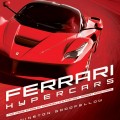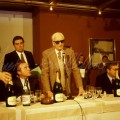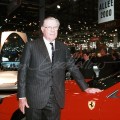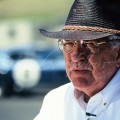 For the past several months I’ve been slaving away on a groundbreaking book on Ferrari supercars that will be out later this year. It’s basically the culmination of all the interviews and research done over the past two-plus decades with key personnel in the most famous name in exotic car building. Those individuals’ voices drive much of the text, giving the reader insight into the hows and whys they created the world’s fastest, most desirable cars the way they did when they made them.
For the past several months I’ve been slaving away on a groundbreaking book on Ferrari supercars that will be out later this year. It’s basically the culmination of all the interviews and research done over the past two-plus decades with key personnel in the most famous name in exotic car building. Those individuals’ voices drive much of the text, giving the reader insight into the hows and whys they created the world’s fastest, most desirable cars the way they did when they made them.
Another of the book’s key elements is the art. The publisher gave me free rein, wanting me to choose every photo, and then put them in the order in which they appear in the book. In addition to my lens, a dozen archives were tapped. A good number of the images haven’t been published before or are rarely seen, and many of them go far beyond showing “just” a car and portray the atmosphere of the time. This way, the reader gets the feel and flavor of the era and world in which the car was made.
oing such a deep dive requires reading a lot of other books. One-hundred-plus are listed in the bibliography, and while most all of them are quite good, some are true standouts. Over the years I’ve been fortunate to do interviews with former Ferrari chief engineer Mauro Forghieri, but those weren’t nearly enough to delve into as much detail as I wanted on Maranello’s move from front to mid-engine cars.While I could have picked up the phone and called, last summer Giorgio Nada Editore made such a call unnecessary by publishing “Forghieri on Ferrari.” Probably the best automotive book I’ve read in years, I can’t recommend this 300+ page work highly enough for Forghieri was the key engineering player in Maranello from the early 1960s through the mid-1980s. His storytelling of the battles with Ford, the Old Man’s resistance to going mid-engine, insights into the Old Man’s character, on Surtees’ leaving Ferrari, the advent of turbocharging in Formula 1 and a whole bunch more is enthralling. The rich art beautifully complements the text and, as usual, Nada’s graphics team did a great job in making a visually pleasing layout.
 Should you want to see Ferrari presented as art, grab a copy of “Ferrari by Mailander;” just realize you will likely need two hands when you do it! This hefty (7+ lbs.) luxurious tome is nearly 400 pages and highlights the work of Rodolfo Mailander, one of the 1950s’ best automotive photographers. The son of German and Italian parents, Mailander was fluent in the two languages and French so he easily moved across borders. This helped him have access to numerous automotive companies in Europe’s tense, post World War II environment, and his story of ambushing Enzo Ferrari at his barber shop after being stood up several times highlights Mailander’s cleverness.
Should you want to see Ferrari presented as art, grab a copy of “Ferrari by Mailander;” just realize you will likely need two hands when you do it! This hefty (7+ lbs.) luxurious tome is nearly 400 pages and highlights the work of Rodolfo Mailander, one of the 1950s’ best automotive photographers. The son of German and Italian parents, Mailander was fluent in the two languages and French so he easily moved across borders. This helped him have access to numerous automotive companies in Europe’s tense, post World War II environment, and his story of ambushing Enzo Ferrari at his barber shop after being stood up several times highlights Mailander’s cleverness.
As do the remarkable photos. I joyfully scoured the rich images, looking for the atmospheric best to consider for my book. There were plenty—and a whole lot more as the book’s prolific author (and Mailander friend) Karl Ludvigsen turned me on to Stanford’s REVS Institute archive, where the Mailander archive now resides. It and numerous others are being scanned constantly, and posted on the Institute’s fabulous website. I spent hours on that site, trying to find something “better” or more atmospheric. For instance, why simply show a 250 P racing at Le Mans in 1963 when you can have an image of the actual race winner, moments after it took the checkered flag?
If Ferraris of the 1980s are your thing, Michael Dregni’s “Inside Ferrari” is a gem. Published in 1990, Dregni had the kind of access manufacturers rarely allow any more, and was given free run of the factory. He used his photographic skills to document it almost like “a day in the life of” the Ferrari factory, and the production line photos are glorious. Plus his words give real insight into the production process, and tell you exactly how the cars were made, and what was going into them.
Should you want to get a sense of what exotics from the 1970s and 80’s were like on the road, and the industry and lifestyle that went with them, no one did it better than Mel Nichols. I first got hooked on him in the second half of the 1970s when he wrote for England’s CAR, and his vivid recounting of driving a Lambo convoy (LP400, Urraco and Silhouette) from the factory in Sant’ Agata to the Lambo concessionaire in the UK remains one of the two best drive stories I’ve ever read.
He’s picked a number of his favorites for the book “And The Revs Keep Rising” that came out last year. A number of entries are on driving Ferraris, visiting Maranello, and meeting Enzo. It’s 400+ pages of pure automotive poetry, and I’ve already given away several copies as presents.
 The early 1980s Group B racing series plays a big role in the 288 GTO story, but not one we have all been lead to believe since the car’s creation (there’s my teaser for one of the revelations in my upcoming book). The bible on those wild four-wheeled missiles, the key people and exactly what happened is “Group B The Rise and Fall of Rallying’s Wildest Cars.” Well written by insiders Richard Davenport and Reinhard Klien, these 250 pages will answer most any question you could ever have on Group B, and is beautifully illustrated. (If you are one who likes to “invest” in cars, these machines and the street offshoots are a great up and coming place to park some money, figuratively and literally!)
The early 1980s Group B racing series plays a big role in the 288 GTO story, but not one we have all been lead to believe since the car’s creation (there’s my teaser for one of the revelations in my upcoming book). The bible on those wild four-wheeled missiles, the key people and exactly what happened is “Group B The Rise and Fall of Rallying’s Wildest Cars.” Well written by insiders Richard Davenport and Reinhard Klien, these 250 pages will answer most any question you could ever have on Group B, and is beautifully illustrated. (If you are one who likes to “invest” in cars, these machines and the street offshoots are a great up and coming place to park some money, figuratively and literally!)
A final recommendation is an old standby, “Red Arrows: Ferrari Cars at the Mille Miglia.” Written by race winner Count Giannino Marzotto, and published by Giorgio Nada Editore, this 264-page book is a marvelous recounting of Ferrari’s endeavors in Italy’s famed 1,000 mile race in the late 1940s and 1950s. Marzotto’s words offer breezy insight into the race, the cars and the competitors, and the photos of out Nada’s Sorlini archive are stupendous. At the end of the book is a lengthy appendix listing every Ferrari that raced by chassis number, coachbuilder, drivers and results.
At the time of this entry some of these books were listed on Amazon.com, but I’ve had better luck buying them my favorite automotive booksellers on both sides of the Atlantic. They are Liberia dell’Automobile in Milan, Shopping Formula 1 in Maranello, Horton’s Motorbooks in London, and Heritage Classic Motorbooks in West Hollywood, California. Sergio Nada at the Libreria and Lucs Fornetti at Shopping Formula both speak good English, and they and Ben Horton and his staff and Michael Duffy at Heritage all know their stuff.
Tell them I sent you, and good reading!
Visit The Goodfellow Perspective for more insights from Winston













